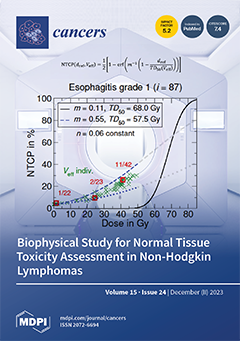Molecular Tumor Boards (MTBs) converge state-of-the-art next-generation sequencing (NGS) methods with the expertise of an interdisciplinary team consisting of clinicians, pathologists, human geneticists, and molecular biologists to provide molecularly informed guidance in clinical decision making to the treating physician. In the present study,
[...] Read more.
Molecular Tumor Boards (MTBs) converge state-of-the-art next-generation sequencing (NGS) methods with the expertise of an interdisciplinary team consisting of clinicians, pathologists, human geneticists, and molecular biologists to provide molecularly informed guidance in clinical decision making to the treating physician. In the present study, we particularly focused on elucidating the factors impacting on the clinical translation of MTB recommendations, utilizing data generated from gene panel mediated comprehensive genomic profiling (CGP) of 554 patients at the MTB of the Comprehensive Cancer Center Erlangen, Germany, during the years 2016 to 2020. A subgroup analysis of cases with available follow-up data (
n = 332) revealed 139 cases with a molecularly informed MTB recommendation, which was successfully implemented in the clinic in 44 (31.7%) of these cases. Here, the molecularly matched treatment was applied in 45.4% (
n = 20/44) of cases for ≥6 months and in 25% (
n = 11/44) of cases for 12 months or longer (median time to treatment failure, TTF: 5 months, min: 1 month, max: 38 months, ongoing at data cut-off). In general, recommendations were preferentially implemented in the clinic when of high (i.e., tier 1) clinical evidence level. In particular, this was the case for MTB recommendations suggesting the application of PARP, PIK3CA, and IDH1/2 inhibitors. The main reason for non-compliance to the MTB recommendation was either the application of non-matched treatment modalities (
n = 30)/stable disease (
n = 7), or deteriorating patient condition (
n = 22)/death of patient (
n = 9). In summary, this study provides an insight into the factors affecting the clinical implementation of molecularly informed MTB recommendations, and careful considerations of these factors may guide future processes of clinical decision making.
Full article






